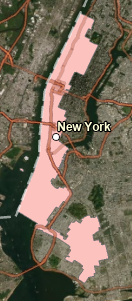Lab 2 [GIS5935]: Data Quality Standards
The image above shows 20 test point locations across a street map for the city of Albuquerque. In selecting these test points to report the horizontal accuracy of two alternative geographic data sources providing street centerlines, the following constraints were applied, in compliance with using the National Standard for Spatial Data Accuracy to measure and report the associated quality (Minnesota Planning Land Management Information Center, 2019):
- Locations were selected using street intersections derived from orthophotos of the study area - these images contained detailed imagery of street centerlines and nearby features (e.g., medians, sidewalks) that could be readily used to accurately determine intersection points.
- Given the street uniformity throughout the region, approximately 25% of the points were derived from each quadrant of the overall study area, and all quadrants were equally represented in this way (meeting the requirement to draw at least 20% of test points from each quadrant).
- Test points were roughly spaced at intervals of at least 10% of the diagonal distance across the data set.
Once these test points were located and saved, the X and Y coordinates of these test points and the location of the corresponding street intersections in the following two alternative geographic data sources were determined:
- City of Albuquerque Streets Sample
- TeleAtlas StreetMap USA Sample
The root mean square error statistic was then calculated for each of these data sets based on the distance differences in the locations of the 20 representative intersection centerpoints compared to the orthophoto-derived test points. This value was then multiplied by 1.7308 to capture the 95% confidence level. The following positional accuracy statements were then derived from these results:
- City of Albuquerque Streets Sample: Tested 20.3 feet horizontal accuracy at 95% confidence interval.
- TeleAtlas StreetMap USA Sample: Tested 442.7 feet horizontal accuracy at 95% confidence interval.
As expected, the City of Albuquerque data set was more accurate. During the lab, oftentimes the test point and the intersection point from this data set were visibly close together within the street intersection area on the orthophoto. This was not the case with the TeleAtlas StreetMap USA data set, where intersection points were rarely within the same intersection noted on the orthophoto and oftentimes could be found to be off by one or more streets.




Comments
Post a Comment